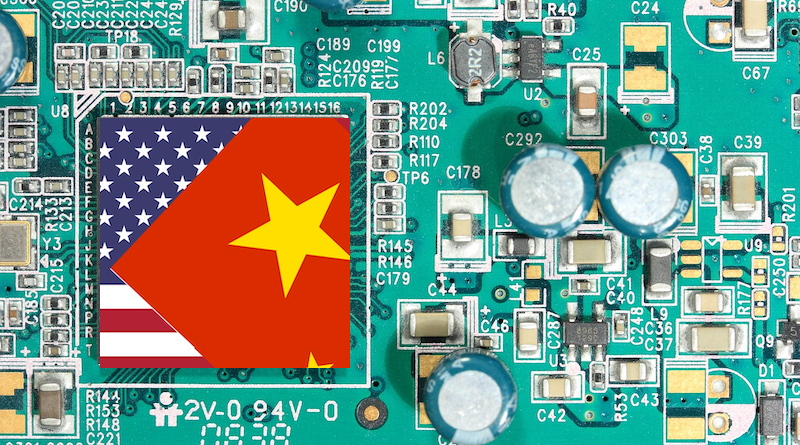The Asymmetrical US-China ‘Technology Cold War’ – Analysis
By Anbound
By He Jun
The policy of decoupling and containment towards China pushed by the United States is most aggressive in the technology field. Although the current state of U.S.-China relations has not yet reached the level of a cold war, researchers at ANBOUND believe that in the technology field, the competition between the two countries has become similar to a “technology cold war”. Due to the difference in the levels of technological and industrial development between the two, this is an asymmetric game, with the U.S. having a significant advantage.
The Institute of International Technology and Economy (IITE), a think tank of China’s State Council has recently published an article titled “Systematic Trends of U.S. Technology Containment towards China”. This article shows the understanding, analysis, and judgment of Chinese official research institutions on the technological competition between the U.S. and China, but also to some extent reflects the possible directions and measures for China to deal with U.S. technology containment.
The article discusses the systematic development of U.S. technological containment against China, which has become clearer and more decisive under the Biden administration. This containment has three key aspects, namely political mobilization, strategic design, and organizational guarantees. The strategy, according to the article, encompasses four pillars, i.e., investment in technology ecology, nurturing top STEM (science, technology, engineering, and mathematics) talent, protecting technological advantages, and integrating alliance partners. This approach covers unilateral, bilateral, and multilateral dimensions and targets specific technological domains. The Biden administration has also set up various task forces in federal departments, including, and additional funds have been allocated through congressional legislation. For example, in August 2022, Biden signed the CHIPS and Science Act, which requires subsidized companies to “choose a side” and not participate in significant deals to expand semiconductor production capacity in China for ten years.
In addition, the IITE article also argues that with its systematic ability to contain China’s technology, the U.S. makes it difficult to depart from the strategic direction of containment. This will normalize technological containment and make U.S.-China scientific cooperation more difficult. The policy will become more precise with more legislation and administrative measures being taken to restrict China’s technological development, even increasingly polarized, as various interest groups push for stricter policies. As a result, according to the article, the rational and friendly voice for U.S.-China relations in Washington is disappearing, making cooperation between the two countries in science and technology more difficult in the future.
Researchers at ANBOUND believe that from the analysis of the IITE article, some relatively clear conclusions can be drawn.
Firstly, China has come to accept that the U.S. is engaging in a long-term and systematic campaign of technological containment against it. With repeated efforts to suppress China’s technological advancements, the U.S.’s policy of containment is unlikely to change and will continue to intensify over time. This strategic adjustment towards China, combined with the prevailing attitude towards China in the American political ecology, suggests that the future of U.S.-China relations is unlikely to improve significantly for a considerable period. As a result, researchers at ANBOUND predict that this situation may continue for 20 to 30 years, which will also mean that such a technological containment against China will last for decades.
Secondly, in the face of the systematic technological containment against China, China will take a comprehensive and strategic approach to respond. Although China recognizes the need for openness in technological and industrial development, it will pursue “independence and controllability” in multiple specific technological industries, promote “de-Americanization” in critical industries, technologies, as well as key areas, and strive for “domestic substitution” in some fields. Furthermore, it may also prepare for extreme situations, such as facing comprehensive sanctions from the West, including technological and related industrial sanctions, in the event of a Taiwan Strait crisis in the future. We believe that relevant departments are actively considering means to respond to this possibility.
Thirdly, the “technology cold war” presents significant challenges for education, technology talent cultivation, and talent utilization in China. Advancements in breakthrough technologies or emerging technology fields depend on professional knowledge and on high-tech talents. Therefore, to achieve long-term technological competitiveness, China will need to invest significantly in building a world-class ecosystem for talent cultivation and development while promoting the coordinated growth of technology, education, and the economy. To achieve these objectives, it must reform its technology talent training mechanism and education system. However, researchers at ANBOUND note that restrictions imposed by the U.S. are only external pressures. Many domestic education and talent mechanisms in China create internal pressure, further hindering the cultivation and utilization of innovative technology talent.
Fourthly, as the U.S. is pushing its allies to join in the technological blockade against China, China must respond to it by maintaining international scientific and technological exchanges, as well as with openness to the greatest extent possible. In various areas such as market sharing, external cooperation, and personnel exchanges, China must increase its exchanges and cooperation with other countries and regions. Breaking through this “technology cold war” network woven by the U.S. is the first step toward success for China.
Final analysis conclusion:
The “technology cold war” initiated by the U.S. based on geopolitical competition against China has taken shape and is continuously strengthening. Faced with such a long-term and systematic technological containment, China now considers a long-term strategy to respond to it. Its education, technology, and industrial sectors need to be prepared for this in the long run.
He Jun is a researcher at ANBOUND

